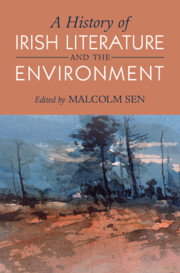Book contents
- A History of Irish Literature and the Environment
- A History of Irish Literature and the Environment
- Copyright page
- Contents
- Figures
- Tables
- Contributors
- Introduction Culture, Climate, Capital, and Contagion
- Chapter 1 Landscape and Literature in Medieval Ireland
- Chapter 2 The Irish Annals and Climate, Fifth–Seventeenth Centuries CE
- Chapter 3 The Environmental Vocabulary of Irish Folklore
- Chapter 4 Narratives of Arboreal Landscapes
- Chapter 5 Famine and Ecology, 1750–1900
- Chapter 6 Political Ecology in Nationalist Literature, 1880–1922
- Chapter 7 Solastalgic Modernism and the West in Irish Literature, 1900–1950
- Chapter 8 The Ecology of the Irish Big House, 1900–1950
- Chapter 9 Refuge and Domestic Space in Northern Irish Poetry, ca. 1940–Present
- Chapter 10 Irish Travellers, the Environment, and Literature
- Chapter 11 The Oceanic Imaginaries of Modern Irish Writing
- Chapter 12 Landscape in Irish-Language Literature: Poetry and Prose, 1900–2000
- Chapter 13 Poetry and Place
- Chapter 14 Animals and Climate Crisis in Irish Poetry
- Chapter 15 Animals and Animality in Irish Fiction
- Chapter 16 The Political Ecology of Food and Hunger, 1950–Present
- Chapter 17 Built Environments and Lived Ecologies in Contemporary Irish Poetry, 1998–Present
- Chapter 18 Transnationalism and Environment in Contemporary Irish Literature
- Chapter 19 Energy Futures in Contemporary Irish Fiction
- Bibliography
- Index
Chapter 1 - Landscape and Literature in Medieval Ireland
Published online by Cambridge University Press: 14 July 2022
- A History of Irish Literature and the Environment
- A History of Irish Literature and the Environment
- Copyright page
- Contents
- Figures
- Tables
- Contributors
- Introduction Culture, Climate, Capital, and Contagion
- Chapter 1 Landscape and Literature in Medieval Ireland
- Chapter 2 The Irish Annals and Climate, Fifth–Seventeenth Centuries CE
- Chapter 3 The Environmental Vocabulary of Irish Folklore
- Chapter 4 Narratives of Arboreal Landscapes
- Chapter 5 Famine and Ecology, 1750–1900
- Chapter 6 Political Ecology in Nationalist Literature, 1880–1922
- Chapter 7 Solastalgic Modernism and the West in Irish Literature, 1900–1950
- Chapter 8 The Ecology of the Irish Big House, 1900–1950
- Chapter 9 Refuge and Domestic Space in Northern Irish Poetry, ca. 1940–Present
- Chapter 10 Irish Travellers, the Environment, and Literature
- Chapter 11 The Oceanic Imaginaries of Modern Irish Writing
- Chapter 12 Landscape in Irish-Language Literature: Poetry and Prose, 1900–2000
- Chapter 13 Poetry and Place
- Chapter 14 Animals and Climate Crisis in Irish Poetry
- Chapter 15 Animals and Animality in Irish Fiction
- Chapter 16 The Political Ecology of Food and Hunger, 1950–Present
- Chapter 17 Built Environments and Lived Ecologies in Contemporary Irish Poetry, 1998–Present
- Chapter 18 Transnationalism and Environment in Contemporary Irish Literature
- Chapter 19 Energy Futures in Contemporary Irish Fiction
- Bibliography
- Index
Summary
This chapter strikingly demonstrates the importance of medieval literary representations of the environment for more contemporary concerns. Amy Mulligan analyzes the medieval figure of the Sovereignty Goddess in literature written in the Irish language and shows its centrality in the environmental education of male rulers. Further relevance of the medieval for the contemporary ecological regime is revealed in treating medieval literature as one that provides a systematic understanding, often surprisingly scientific, such as Gerald of Wales’s accounts, “of Ireland’s birds and fishes” that are “invaluable in describing species, some of which are now extinct” and can act as guide to understand the nature of “ecological imperialism” in Ireland. Mulligan concludes that “All these medieval practitioners of Irish nature-writing develop a mode of thinking about the environment as a creative and generative space, one which is highly anthropocentric but which, through adoration, wonder, even recognition of something divine in the trees, soil, water, and animals” makes continued human habitability on this planet a historical possibility.
- Type
- Chapter
- Information
- A History of Irish Literature and the Environment , pp. 33 - 51Publisher: Cambridge University PressPrint publication year: 2022
- 1
- Cited by

